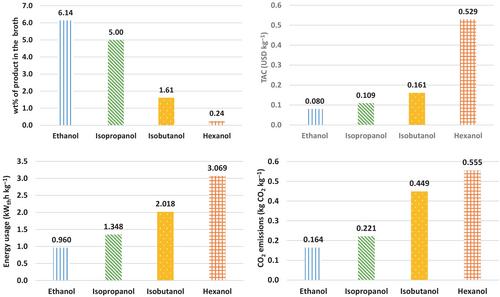下载PDF
{"title":"生物醇回收下游加工性能透视","authors":"Tamara Janković, Adrie JJ Straathof, Anton A Kiss","doi":"10.1002/jctb.7690","DOIUrl":null,"url":null,"abstract":"<p>Even though industrial biotechnology is successfully used for the production of some chemicals, for many other chemicals it is not yet competitive with conventional petrochemical production. Usually, fermentation as well as downstream processing requires improvement. Downstream processing has to deal with low product concentrations, microorganisms, impurities and thermodynamic constraints (e.g., azeotropes), which often makes it very challenging and expensive, especially on a large scale. However, downstream processing of biochemicals has not attracted as much attention as upstream fermentation processes. In that context, this perspective paper offers a lightly referenced scholarly opinion about the downstream processing performance of different bioalcohols after fermentation. Due to the stronger toxicity effects on microbes, the achievable concentrations of monohydric aliphatic alcohols in the fermentation broth decrease with the increasing chain length. Specifically, the concentrations used here are 6.14, 5.00, 1.61 and 0.24 wt% of ethanol, isopropanol, isobutanol and hexanol, respectively. More dilute fermentation broths lead to more complex recovery processes. According to our previous work, the total purification costs increase from 0.080 USD kg<sup>−1</sup> for ethanol, 0.109 USD kg<sup>−1</sup> for isopropanol and 0.161 USD kg<sup>−1</sup> for isobutanol to 0.529 USD kg<sup>−1</sup> for hexanol. A similar trend is noticeable for the energy usage (0.960, 1.348, 2.018 and 3.069 kW<sub>th</sub>h kg<sup>−1</sup>, respectively) and the related CO<sub>2</sub> emissions (0.164, 0.221, 0.449 and 0.555 kg<sub>CO2</sub> kg<sup>−1</sup>, respectively). This work shows that advanced separation and purification based on process intensification principles are crucial for overall efficient production processes. The achievable product concentration in the fermentation broth – and not so much the alcohol chain length – has the biggest influence on the performance of downstream processing. Therefore, simultaneous development of both upstream and downstream processing is necessary to ensure the competitiveness and viability of industrial fermentation processes. © 2024 The Author(s). <i>Journal of Chemical Technology and Biotechnology</i> published by John Wiley & Sons Ltd on behalf of Society of Chemical Industry (SCI).</p>","PeriodicalId":15335,"journal":{"name":"Journal of chemical technology and biotechnology","volume":"99 9","pages":"1933-1940"},"PeriodicalIF":2.8000,"publicationDate":"2024-05-31","publicationTypes":"Journal Article","fieldsOfStudy":null,"isOpenAccess":false,"openAccessPdf":"https://onlinelibrary.wiley.com/doi/epdf/10.1002/jctb.7690","citationCount":"0","resultStr":"{\"title\":\"A perspective on downstream processing performance for recovery of bioalcohols\",\"authors\":\"Tamara Janković, Adrie JJ Straathof, Anton A Kiss\",\"doi\":\"10.1002/jctb.7690\",\"DOIUrl\":null,\"url\":null,\"abstract\":\"<p>Even though industrial biotechnology is successfully used for the production of some chemicals, for many other chemicals it is not yet competitive with conventional petrochemical production. Usually, fermentation as well as downstream processing requires improvement. Downstream processing has to deal with low product concentrations, microorganisms, impurities and thermodynamic constraints (e.g., azeotropes), which often makes it very challenging and expensive, especially on a large scale. However, downstream processing of biochemicals has not attracted as much attention as upstream fermentation processes. In that context, this perspective paper offers a lightly referenced scholarly opinion about the downstream processing performance of different bioalcohols after fermentation. Due to the stronger toxicity effects on microbes, the achievable concentrations of monohydric aliphatic alcohols in the fermentation broth decrease with the increasing chain length. Specifically, the concentrations used here are 6.14, 5.00, 1.61 and 0.24 wt% of ethanol, isopropanol, isobutanol and hexanol, respectively. More dilute fermentation broths lead to more complex recovery processes. According to our previous work, the total purification costs increase from 0.080 USD kg<sup>−1</sup> for ethanol, 0.109 USD kg<sup>−1</sup> for isopropanol and 0.161 USD kg<sup>−1</sup> for isobutanol to 0.529 USD kg<sup>−1</sup> for hexanol. A similar trend is noticeable for the energy usage (0.960, 1.348, 2.018 and 3.069 kW<sub>th</sub>h kg<sup>−1</sup>, respectively) and the related CO<sub>2</sub> emissions (0.164, 0.221, 0.449 and 0.555 kg<sub>CO2</sub> kg<sup>−1</sup>, respectively). This work shows that advanced separation and purification based on process intensification principles are crucial for overall efficient production processes. The achievable product concentration in the fermentation broth – and not so much the alcohol chain length – has the biggest influence on the performance of downstream processing. Therefore, simultaneous development of both upstream and downstream processing is necessary to ensure the competitiveness and viability of industrial fermentation processes. © 2024 The Author(s). <i>Journal of Chemical Technology and Biotechnology</i> published by John Wiley & Sons Ltd on behalf of Society of Chemical Industry (SCI).</p>\",\"PeriodicalId\":15335,\"journal\":{\"name\":\"Journal of chemical technology and biotechnology\",\"volume\":\"99 9\",\"pages\":\"1933-1940\"},\"PeriodicalIF\":2.8000,\"publicationDate\":\"2024-05-31\",\"publicationTypes\":\"Journal Article\",\"fieldsOfStudy\":null,\"isOpenAccess\":false,\"openAccessPdf\":\"https://onlinelibrary.wiley.com/doi/epdf/10.1002/jctb.7690\",\"citationCount\":\"0\",\"resultStr\":null,\"platform\":\"Semanticscholar\",\"paperid\":null,\"PeriodicalName\":\"Journal of chemical technology and biotechnology\",\"FirstCategoryId\":\"5\",\"ListUrlMain\":\"https://onlinelibrary.wiley.com/doi/10.1002/jctb.7690\",\"RegionNum\":4,\"RegionCategory\":\"生物学\",\"ArticlePicture\":[],\"TitleCN\":null,\"AbstractTextCN\":null,\"PMCID\":null,\"EPubDate\":\"\",\"PubModel\":\"\",\"JCR\":\"Q3\",\"JCRName\":\"BIOTECHNOLOGY & APPLIED MICROBIOLOGY\",\"Score\":null,\"Total\":0}","platform":"Semanticscholar","paperid":null,"PeriodicalName":"Journal of chemical technology and biotechnology","FirstCategoryId":"5","ListUrlMain":"https://onlinelibrary.wiley.com/doi/10.1002/jctb.7690","RegionNum":4,"RegionCategory":"生物学","ArticlePicture":[],"TitleCN":null,"AbstractTextCN":null,"PMCID":null,"EPubDate":"","PubModel":"","JCR":"Q3","JCRName":"BIOTECHNOLOGY & APPLIED MICROBIOLOGY","Score":null,"Total":0}
引用次数: 0
引用
批量引用


